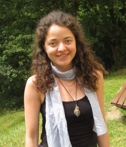Mariami Gachechiladze
 PhD student
PhD student
Room: B-111
Phone: +49 271 740 3716
Preprints
See also arxiv
Mariami Gachechiladze, Otfried Gühne and Akimasa Miyake
Changing the circuit-depth complexity of measurement-based quantum
computation with hypergraph states
 arXiv:1805.12093
arXiv:1805.12093
The circuit model of quantum computation defines its logical depth or "computational time" in terms of temporal gate sequences, but the measurement-based model could allow totally different time ordering and parallelization of logical gates. We introduce a deterministic scheme of universal measurement-based computation, using only Pauli measurements on multi-qubit hypergraph states generated by the Controlled-Controlled-Z (CCZ) gates. In contrast to the cluster-state scheme where the Clifford gates are parallelizable, our scheme enjoys massive parallelization of CCZ and SWAP gates, so that the computational depth grows with the number of global applications of Hadamard gates, or, in other words, with the number of changing computational bases. An exponentially-short depth implementation of an N-times Controlled-Z gate illustrates a novel trade-off between space and time complexity.
Publications
M. Hebenstreit, M. Gachechiladze, O. Gühne and B. Kraus
The Entanglement Hierarchy 2 x m x n Systems
 Phys. Rev. A 97,
032330
(2018),
arXiv:1710.00981
Phys. Rev. A 97,
032330
(2018),
arXiv:1710.00981
We consider three-partite pure states in the Hilbert space $\mathbb{C}^2 \otimes \mathbb{C}^m \otimes \mathbb{C}^n$ and investigate to which states a given state can be locally transformed with a non-vanishing probability. Whenever the initial and final states are elements of the same Hilbert space, the problem can be solved via the characterization of the entanglement classes which are determined via stochastic operations and classical communication (SLOCC). In general, there are infinitely many SLOCC classes. However, when considering transformations from higher- to lower-dimensional Hilbert spaces, an additional hierarchy among the classes can be found. This hierarchy of SLOCC classes coarse grains SLOCC classes which can be reached from a common resource state of higher dimension. We first show that a generic set of states in $\mathbb{C}^2 \otimes \mathbb{C}^m \otimes \mathbb{C}^n$ for $n=m$ is the union of infinitely many SLOCC classes, which can be parameterized by $m-3$ parameters. However, for $n \neq m$ there exists a single SLOCC class which is generic. Using this result, we then show that there is a full-measure set of states in $\mathbb{C}^2 \otimes \mathbb{C}^m \otimes \mathbb{C}^n$ such that any state within this set can be transformed locally to a full measure set of states in any lower-dimensional Hilbert space. We also investigate resource states, which can be transformed to any state (not excluding any zero-measure set) in the smaller-dimensional Hilbert space. We explicitly derive a state in $\mathbb{C}^2 \otimes \mathbb{C}^m \otimes \mathbb{C}^{2m-2}$ which is the optimal common resource of all states in $\mathbb{C}^2 \otimes \mathbb{C}^m \otimes \mathbb{C}^m$. We also show that for any $n < 2m$ it is impossible to reach all states in $\mathbb{C}^2 \otimes \mathbb{C}^m \otimes \mathbb{C}^{\tilde{n}}$ whenever $\tilde{n}>m$.
Mariami Gachechiladze, Nikolai Wyderka and Otfried Gühne
The structure of ultrafine entanglement witnesses
 J. Phys. A: Math. Theor. 51,
365307
(2018),
arXiv:1805.06404
J. Phys. A: Math. Theor. 51,
365307
(2018),
arXiv:1805.06404
An entanglement witness is an observable with the property that a negative expectation value signals the presence of entanglement. The question arises how a witness can be improved if the expectation value of a second observable is known, and methods for doing this have recently been discussed as so-called ultrafine entanglement witnesses. We present several results on the characterization of entanglement given the expectation values of two observables. First, we explain that this problem can naturally be tackled with the method of the Legendre transformation, leading even to a quantification of entanglement. Second, we present necessary and sufficient conditions that two product observables are able to detect entanglement. Finally, we explain some fallacies in the original construction of ultrafine entanglement witnesses [F. Shahandeh et al., Phys. Rev. Lett. 118, 110502 (2017)].
Mariami Gachechiladze and Otfried Gühne
Completing the proof of "Generic quantum nonlocality"
 Phys. Lett. A 381,
1281
(2017),
arXiv:1607.02948
Phys. Lett. A 381,
1281
(2017),
arXiv:1607.02948
In a paper by Popescu and Rohrlich [Phys. Lett. A 166, 293 (1992)] a proof has been presented showing that any pure entangled multiparticle quantum state violates some Bell inequality. We point out a gap in this proof, but we also give a construction to close this gap. It turns out that with some extra effort all the results from the aforementioned publication can be proven. Our construction shows how two-particle entanglement can be generated via performing local projections on a multiparticle state.
Mariami Gachechiladze, Nikoloz Tsimakuridze and Otfried Gühne
Graphical description of unitary transformations on hypergraph states
 J. Phys. A: Math. Theor. 50,
19LT01
(2017),
arXiv:1612.01447
J. Phys. A: Math. Theor. 50,
19LT01
(2017),
arXiv:1612.01447
Hypergraph states form a family of multiparticle quantum states that generalizes cluster states and graph states. We study the action and graphical representation of nonlocal unitary transformations between hypergraph states. This leads to a generalization of local complementation and graphical rules for various gates, such as the CNOT gate and the Toffoli gate. As an application, we show that already for five qubits local Pauli operations are not sufficient to check local equivalence of hypergraph states. Furthermore, we use our rules to construct entanglement witnesses for three-uniform hypergraph states.
Mariami Gachechiladze, Costantino Budroni and Otfried Gühne
Extreme violation of local realism in quantum hypergraph states
 Phys. Rev. Lett. 116,
070401
(2016),
arXiv:1507.03570
Phys. Rev. Lett. 116,
070401
(2016),
arXiv:1507.03570
Hypergraph states form a family of multiparticle quantum states that generalizes the well-known concept of Greenberger-Horne-Zeilinger states, cluster states, and more broadly graph states. We study the nonlocal properties of quantum hypergraph states. We demonstrate that the correlations in hypergraph states can be used to derive various types of nonlocality proofs, including Hardy-type arguments and Bell inequalities for genuine multiparticle nonlocality. Moreover, we show that hypergraph states allow for an exponentially increasing violation of local realism which is robust against loss of particles. Our results suggest that certain classes of hypergraph states are novel resources for quantum metrology and measurement-based quantum computation.
Master Thesis

